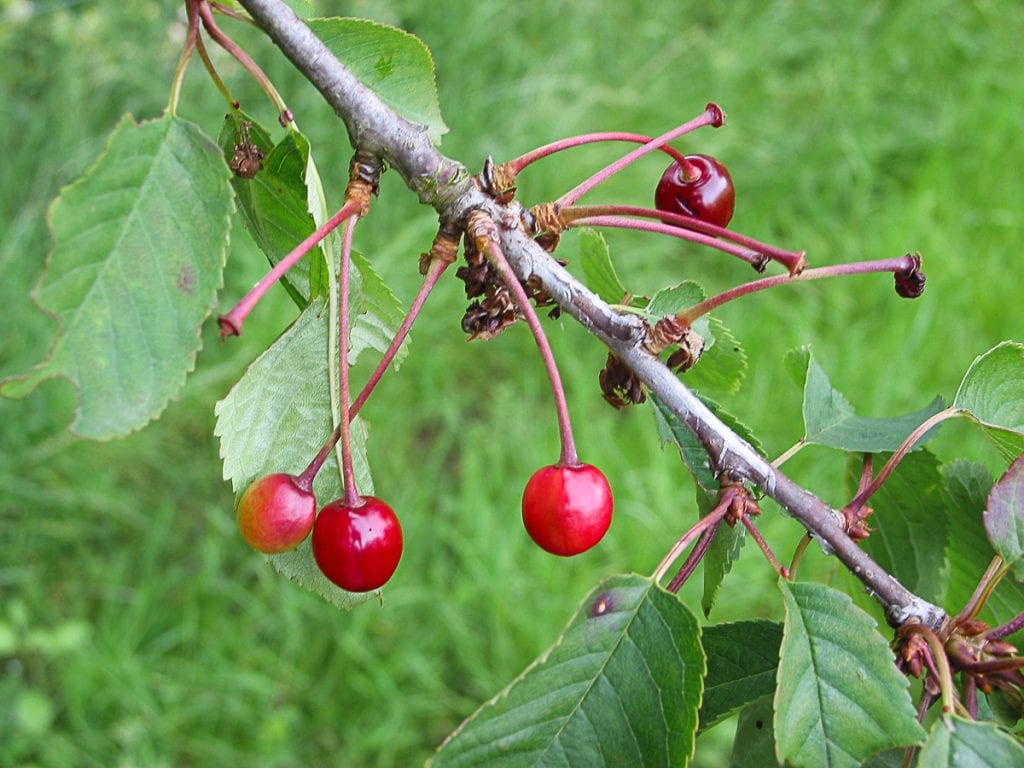With their graceful form, attractive bark, and bursts of spring blossoms, wild cherry trees have captivated people for centuries. Also known by their scientific name Prunus avium, wild cherries produce sweet, dark red edible fruits beloved by birds and humans alike.
Let’s explore some eye-catching photos that highlight the distinctive features of wild cherry trees throughout the seasons
Spring Blossoms
One of the most spectacular displays of a wild cherry tree occurs in spring when their fragrant white flowers burst into bloom, usually in April or May. The flowers appear in clusters of 5-6 blooms on slender, long stalks. The blooms have an elegant cup shape with oval petals. When in full bloom, a wild cherry tree can appear as a fluffy white cloud.
![White cherry blossoms blooming against a blue sky][]
Summer Fruit
After pollination occurs, the flowers give way to dangling clusters of shiny red wild cherries in summer Ranging in color from bright red to nearly black when fully ripe, the fruits are smaller than cultivated cherry varieties but offer a sweet-tart wild cherry flavor. The fruits yellow jackets, bees, and birds who feast on the bounty![Red wild cherries hanging from a tree branch][]
Fall Foliage
As summer ends, the green oval leaves of the wild cherry transition to hues of yellow, orange, bronze, and red before dropping in autumn. The foliage provides a beautiful pop of color alongside the bark.![Wild cherry tree with red and yellow fall leaves][]
Bark and Twigs
Easy to recognize in winter, wild cherry bark has a unique pattern of horizontal stripes. The bark is mostly reddish-brown but with prominent buff-colored lenticels dotted along the trunk in lines. The bark can peel off in places. Twigs are slender and reddish, with small, clustered buds.![Close up image of wild cherry tree bark][]
Growing Habitat
In the wild, cherry trees thrive on the sunny edges of deciduous forests and woodlands. They require nutrient-rich, moist soil. The trees flower early to get sufficient sunlight before the forest canopy fills in. Wild cherries frequently occur along fencerows, streams, and roadsides.![Wild cherry trees blooming along a forest edge][]
Ornamental Uses
The graceful form, cascading white blooms, and attractive foliage of wild cherry trees make them a favorite ornamental specimen. They are frequently planted in parks, yards, and along streets for beauty. Cultivars have been selected for enhanced flower production and fruit size.![Ornamental cherry tree in bloom][]
The unique characteristics of wild cherry trees shine through year-round in these lovely photos. Bark, leaves, flowers, fruit, and form come together to create a beautiful package. Keep an eye out for wild cherries gracing woodland edges and urban plantings.
Not to be confused with:
Trees woods and wildlife
Download our free Tree ID app for Android and iPhone to identify the UKs native and non-native trees. Its an A-Z tree guide in your pocket.
Credit: Richard Becker / WTML
What does wild cherry look like?
Credit: Klein & Hubert / naturepl.com
oval, green, toothed, and tipped with a point; 6–15 cm long; two red glands on the stalk at the base of the leaf They fade to orange and deep crimson in autumn.
Credit: Paul Coppi / WTML
Cherry trees are hermaphrodite, meaning the male and female reproductive parts are found in the same flower. Flowers, measuring 8–15mm across appear in April and are white and cup-shaped, with five petals. They hang in clusters of two to six.
Credit: Brian Legg / WTML
After pollination by insects, the flowers develop into globular, hairless, deep-red cherries.
Wild Cherry – How to find, identify, locate, and process Wild Cherry Syrup
FAQ
Can you eat wild cherries from a wild cherry tree?
What is the difference between cherry and wild cherry?
Where do wild cherry trees grow?
What is a wild cherry tree?
Sterile cultivars are the best choice. Wild Cherry is a large tree with a thick trunk to 5 ft across, smooth purplish-brown bark, and prominent horizontal gray-brown lenticels. Bark becomes thick, dark blackish-brown, and shallowly grooved when mature.
What does a wild cherry tree look like?
Wild cherry trees have blossoms of single white flowers that bloom in spring. Depending on the cultivar, fruits from cherry trees can be crimson red, golden yellow, or reddish-purple. Wild cherry trees are unique with their smooth reddish-burgundy bark.
Where do cherry trees grow?
Often found on the edge of woodlands on alkaline soil, wild cherry can form a sizeable tree. Here it is at the edge of its natural distribution and tends to remain relatively small. In warmer European countries it may make quite a large tree and is widely grown for timber.
What are the most common cherry fruit tree types?
In this article, we will guide you through the most common cherry fruit tree types, complete with pictures. The most common cherry fruit tree types are the sweet cherry (Prunus avium) and the sour cherry (Prunus cerasus). Sweet cherries, like Bing and Rainier, are typically eaten fresh.
- The Ultimate Guide to Growing Strawberries in Raised Beds - August 8, 2025
- No-Dig Garden Beds: The Easiest Way to Grow a Beautiful Garden - August 6, 2025
- How to Protect and Preserve Wood for Raised Garden Beds - August 6, 2025

